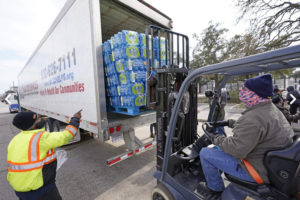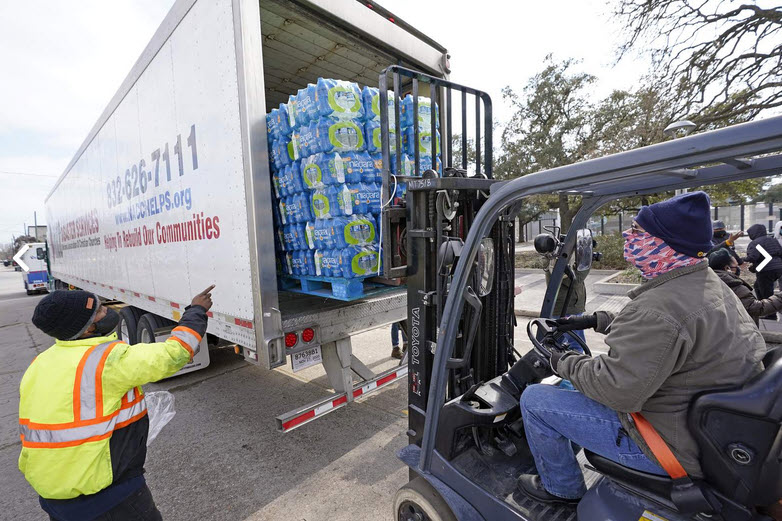 AUSTIN, Texas – Power was restored to more homes and businesses Thursday in states hit by a deadly blast of winter that overwhelmed the electrical grid and left millions shivering in the cold this week. But the crisis was far from over in parts of the South, where many people still lacked safe drinking water.
AUSTIN, Texas – Power was restored to more homes and businesses Thursday in states hit by a deadly blast of winter that overwhelmed the electrical grid and left millions shivering in the cold this week. But the crisis was far from over in parts of the South, where many people still lacked safe drinking water.
In Texas on Thursday, about 325,000 homes and businesses remained without power, down from about 3 million a day earlier, though utility officials said limited rolling blackouts were still possible.
The storms also left more than 320,000 homes and businesses without power in Louisiana, Mississippi and Alabama. About 70,000 power outages persisted after an ice storm in eastern Kentucky, while nearly 67,000 were without electricity in West Virginia.
And more than 100,000 customers remained without power Thursday in Oregon, a week after a massive snow and ice storm. Maria Pope, the CEO of Portland General Electric, said she expects power to be restored by Friday night to more than 90% of the customers still in the dark.
Meanwhile, snow and ice moved into the Appalachians, northern Maryland and southern Pennsylvania, and later the Northeast. Back-to-back storms left 15 inches (38 centimeters) of snow in Little Rock, Arkansas, tying a 1918 record, the National Weather Service said.
The extreme weather was blamed for the deaths of more than four dozen people, some while trying to keep warm. In the Houston area, one family died from carbon monoxide as their car idled in their garage. A woman and her three grandchildren were killed in a fire that authorities said might have been caused by a fireplace they were using.
Utilities from Minnesota to Texas implemented rolling blackouts to ease strained power grids. Southwest Power Pool, a group of utilities covering 14 states from the Dakotas to the Texas Panhandle, said rolling blackouts were no longer needed, but asked customers to conserve energy until at least Saturday night.
Texas’ remaining outages were mostly weather-related, rather than forced blackouts, according to the state’s grid manager, the Electric Reliability Council of Texas. ERCOT Senior Director of System Operations Dan Woodfin said rotating outages could return if electricity demand rises as people get power and heating back, though they wouldn’t last as long as outages earlier this week.
Texas Gov. Greg Abbott warned that state residents “are not out of the woods,” with temperatures still well below freezing statewide, south central Texas threatened by a winter storm and disruptions in food supply chains.
Adding to the state’s misery, the weather jeopardized drinking water systems. Authorities ordered 7 million people — a quarter of the population of the nation’s second-largest state — to boil tap water before drinking it, following record low temperatures that damaged infrastructure and pipes.
Water pressure dropped after lines froze, and because many people left faucets dripping to prevent pipes from icing over, said Toby Baker, executive director of the Texas Commission on Environmental Quality. Abbott urged residents to shut off water to their homes to prevent more busted pipes and preserve pressure in municipal systems.
Houston Mayor Sylvester Turner said he expects that residents in the nation’s fourth-largest city will have to boil tap water before drinking it until Sunday or Monday.
FEMA sent generators to support water treatment plants, hospitals and nursing homes in Texas, along with thousands of blankets and ready-to-eat meals, officials said. The Texas Restaurant Association also said it was coordinating donations of food to hospitals.
Some Austin hospitals lost water pressure and heat. But because the problem was statewide and affected other facilities, “no one hospital currently has the capacity to accept transport of a large number of patients,” said David Huffstutler, CEO of St. David’s South Austin Medical Center.
Two of Houston Methodist’s community hospitals had no running water but still treated patients, with most non-emergency surgeries and procedures canceled for Thursday and possibly Friday, said spokeswoman Gale Smith.
Emergency rooms were crowded “due to patients being unable to meet their medical needs at home without electricity,” Smith said.
Texas Children’s Hospital’s main campus at the Texas Medical Center and another location had low water pressure, but the system was adequately staffed and patients had enough water and “are safe and comfortable,” spokeswoman Jenn Jacome said.
The next phase of the state’s disaster response will be to test drinking water from systems knocked offline by the cold. As of Thursday afternoon, more than 1,000 Texas public water systems and 177 of the state’s 254 counties had reported weather-related operational disruptions, affecting more than 14 million people, according to the Texas Commission on Environmental Quality.
The weather also disrupted water systems in Southern cities, including New Orleans, and Shreveport, Louisiana, where fire trucks delivered water to hospitals and bottled water was brought in for patients and staff, Shreveport television station KSLA reported.
Power was cut to a New Orleans facility that pumps drinking water from the Mississippi River and generators were used until electricity was restored.
And in Jackson, Mississippi, Mayor Chokwe Antar Lumumba said almost the entire city of about 150,000 was without water Thursday night.
Crews were pumping water to refill city’s tanks but faced a shortage of chemicals to treat the water, Lumumba said.
“We are dealing with an extreme challenge with getting more water through our distribution system,” he said.
Drinking water was made available at fire stations throughout Jackson and officials also planned to set up bottled water pickup sites.
About 85 seniors in one Jackson apartment building haven’t had water since Monday and were relying on deliveries from a building manager, said resident Linda Weathersby.
Weathersby said she spent part of Thursday outside collecting buckets of ice to melt it so she could flush her toilet and said “my back’s hurting now.”
As the storms headed east, 12 people had to be rescued Wednesday night from boats after a dock weighed down by snow and ice collapsed on Tennessee’s Cumberland River, the Nashville Fire Department said. Elsewhere in the state, a 9-year-old boy was killed when the tube his father was pulling behind an ATV slammed into a mailbox.
In and around the western Texas city of Abilene, authorities said six people died of the cold — including a 60-year-old man found dead in his bed in his frigid home and a man who died at a health care facility when a lack of water pressure made medical treatment impossible.
A 69-year-old Arkansas man was found dead Wednesday after falling into a frozen pond while trying to rescue a calf. In Kentucky, a 77-year-old woman was found dead of likely hypothermia Wednesday night after two days without power and heat.
And a man fell through the ice on the Detroit River on Wednesday night and likely drowned, a U.S. Coast Guard spokesman said.
Before the wintry weather moved from Texas, the city of Del Rio along the U.S.-Mexico border, got nearly 10 inches (25.4 cm) of snow on Thursday, surpassing the city’s one-day record for snowfall. Up to 3 inches (7.6 cm) were forecast for San Antonio, and Mayor Ron Nirenberg urged residents to stay off treacherous roads.
Source: https://www.ksat.com/news/2021/02/18/power-outages-linger-for-millions-as-another-icy-storm-looms/

